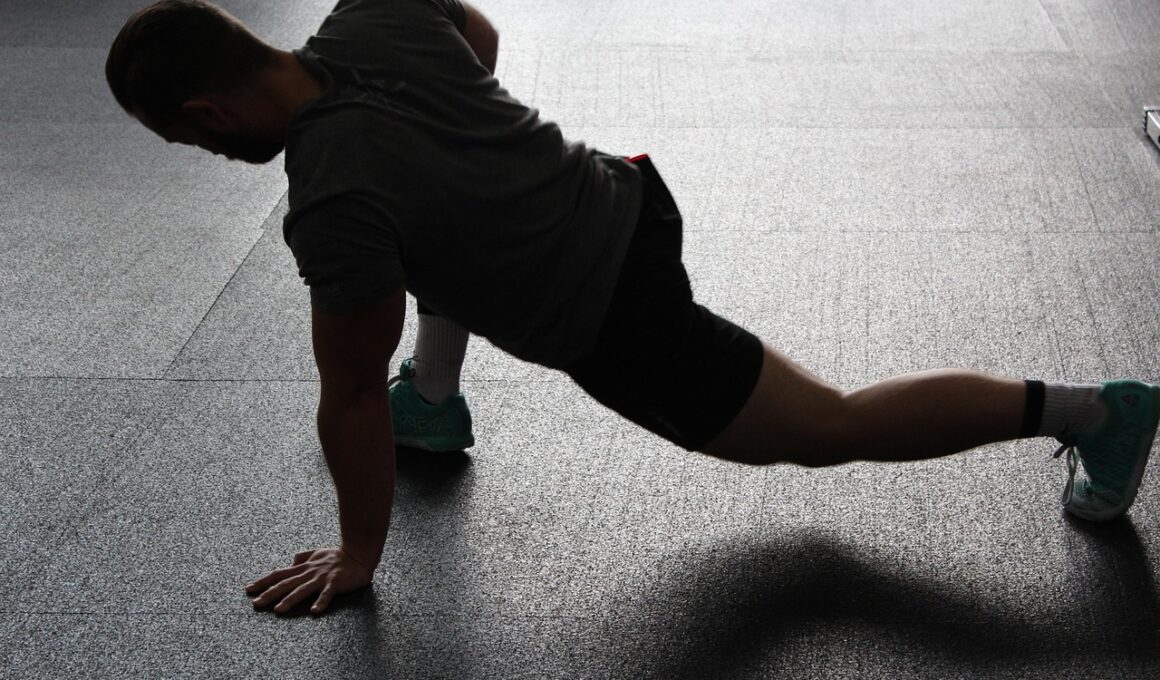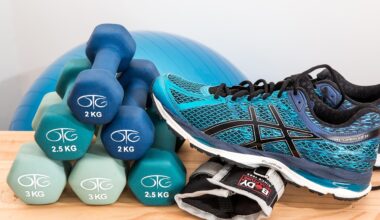The Science Behind Dynamic Warm-Ups in Functional Training
Dynamic warm-ups are vital for preparing the body for functional training. They involve movement-based exercises that enhance muscle flexibility and promote blood flow to active areas. A well-designed dynamic warm-up routine can significantly reduce injury risks and improve athletic performance. Incorporating various movements mimicking actual workout activities prepares the neuromuscular system for the upcoming intensity. It is essential to focus on the range of motion, core stability, and balance during these routines. By gradually increasing heart rate and breaking a sweat, athletes engage both physically and mentally, enhancing overall readiness. Scientific studies indicate that dynamic warm-ups can boost muscle temperature and enhance enzymatic activity within the muscle fibers, leading to more efficient performance. These routines often include mobilizations, leg swings, and torso twists to activate key muscle groups. For optimal results, dancers, athletes, and fitness enthusiasts should consider duration and intensity. A systematic approach towards dynamic warm-ups is fundamental, as insufficient preparation can lead to decreased performance levels. Engaging and varied warm-ups keep things exciting, making fitness more attainable and enjoyable.
Incorporating a variety of movements is essential in dynamic warm-ups. These movements target specific muscle groups involved in functional training, such as squats, lunges, and mobility exercises. A key objective is to increase blood circulation to muscles while stimulating the nervous system. Additionally, performing dynamic movements creates muscle memory, preparing the brain and body for complex tasks during the actual workout. Practicing controlled yet continuous motion helps muscles adapt to the load and duration required in functional training. Traditional static stretching can decrease muscle strength; thus, dynamic warm-ups replace these with movements that mimic workout activities. Gradual transitions between exercises are also crucial to maintain heart rate and momentum. Options like high knees, butt kicks, and arm circles can elevate core temperature and activate muscle fibers. Furthermore, utilizing dynamic warm-ups within functional training enhances proprioception, which is your body’s sense of position. This buildup prepares athletes for unpredictable environments during physical activity, enhancing performance and agility. It is advantageous for trainers and participants to collaborate on personalized warm-up routines. Understanding individual needs is crucial for addressing specific muscle groups and ensuring peak performance.
The Role of Dynamic Warm-Ups in Injury Prevention
Focusing on injury prevention is another essential aspect of dynamic warm-ups in functional training. Research indicates that dynamic warm-ups can significantly reduce the likelihood of injuries, especially in sports that demand quick movements and transitions. By increasing muscle elasticity, dynamic warm-ups prepare the muscle-tendon units, which can decrease the risk of strains and sprains. Effective warm-ups should ideally include sport-specific actions; they target the same muscle groups that will be engaged during training or competition. Engaging in these exercises promotes stability and coordination, which are crucial for movements like cutting and jumping. The repetitive nature of dynamic warm-ups also builds neuromuscular efficiency and response time, ensuring athletes can react promptly to physical demands. Addressing both the upper and lower body during warm-ups assists in creating balanced strength and flexibility. Any deficits identified in the warm-up can signal areas to work on during training. Tailored warm-up routines may incorporate single-leg exercises and lateral movements to specifically target vulnerable areas. Commitment to consistent warm-ups enhances resilience, equipping athletes to manage physical challenges effectively without injury.
Furthermore, athletes should not underestimate the mental component of dynamic warm-ups. Preparing mentally for the workout is as crucial as physical conditioning. Dynamic warm-ups provide a unique opportunity for individuals to focus their mind on the upcoming tasks. A routine helps form a mental connection between the body and desired movements. Individualized warm-ups facilitate engagement and personal ownership of the process, which can lead to better psychological readiness. Athletes should cultivate a presence of mind during this time; mindfulness can enhance muscle control and intentional movement. Practicing visualization can help reinforce goals and expectations for the session. Warm-ups serve as a transition from daily activities into a focused training mindset. They provide necessary time to mentally prepare, setting intentions for athletic performance. Additionally, it fosters team camaraderie when participants engage in warm-ups together, nurturing motivation and energy within the group. Moreover, trainers should encourage discussions about mental strategies during warm-ups to ensure mental and emotional readiness. Dynamic warm-ups, when integrated into a well-rounded program, address both physical and psychological aspects of training, promoting comprehensive athlete development.
Best Practices for Dynamic Warm-Up Routines
Implementing effective dynamic warm-up routines takes careful consideration of best practices. Firstly, ensure that warm-ups are tailored to the specific activities that will follow; this personalization enhances efficacy. Generally, the duration should range between 10 to 15 minutes, gradually increasing heart rate and muscle activation. It is also vital to ensure movements are performed in a controlled manner, focusing on quality over quantity. Using a structured approach, trainers can lead participants through 5 to 10 distinct exercises targeting major muscle groups. For example, incorporating skips, high knees, and leg swings fosters proper mobility while improving balance. Additionally, the inclusion of rhythm and coordination drills enhances overall movement quality. Athletes can consider active stretches such as lunges with a twist, which promotes functional flexibility. Engaging pairs or small groups can motivate participants by fostering camaraderie and promoting accountability. Trainers should also offer modifications for different abilities, ensuring inclusivity. Regularly changing warm-up routines prevents the development of stagnant habits and keeps workouts engaging. It is essential to assess the efficacy of warm-ups continuously, making adjustments as necessary based on performance feedback.
Furthermore, individuals can optimize dynamic warm-ups further by incorporating technology. Utilizing performance tracking devices can provide insights into warm-up effectiveness and overall progress. Heart rate monitors, for instance, can help gauge intensity, ensuring participants reach appropriate levels before diving into functional training. Wearable technology reveals key metrics, such as recovery times, which can assist in determining the success of warm-up strategies. Video analysis of warm-up performances may enhance technique recognition, fostering informed corrections and adjustments. Additionally, connectivity through fitness apps can encourage users to share experiences, allowing for community support and collaboration. Besides performance tracking, platforms featuring instructional videos can enhance understanding of proper warm-up techniques, delivering a comprehensive learning experience. Trainers might also consider integrating multi-dimensional movements; these involve varying planes of motion, promoting holistic muscle engagement. As data collection continues to evolve, personalized warm-up protocols may emerge, addressing individual variances related to biomechanics and body mechanics. Continuous improvements in warm-up routines, guided by technology, can lead to enhanced athletic preparation, injury prevention, and overall performance during functional training.
Conclusion: The Impact of Dynamic Warm-Ups
In conclusion, dynamic warm-ups are integral components of functional training, emphasizing both physical preparation and mental readiness. The significance of these routines has been supported through extensive research, establishing clear links between warm-ups and performance enhancement. By incorporating dynamic movements into training regimens, athletes can see improvements in strength, flexibility, and agility while minimizing injury risks. As trainers craft individualized warm-up routines, participants can better connect with the tasks, improving engagement and motivation. The emphasis on injury prevention and muscle readiness speaks to the holistic benefits of effective warm-ups. Additionally, awareness and utilization of modern technology can accelerate progress, providing tailored experiences adapted to individual needs. Practicing innovative and varied warm-ups can foster excitement, ensuring participants remain engaged. Cumulatively, dynamic warm-ups provide gateways into profound functional fitness benefits. As fitness enthusiasts, athletes, and trainers refine their routines, continual adaptation to new science, technology, and feedback is vital. Committing to this approach will undoubtedly enhance performance, longevity in sport, and overall enjoyment in training.
This is another paragraph with exactly 190 words…


